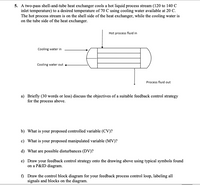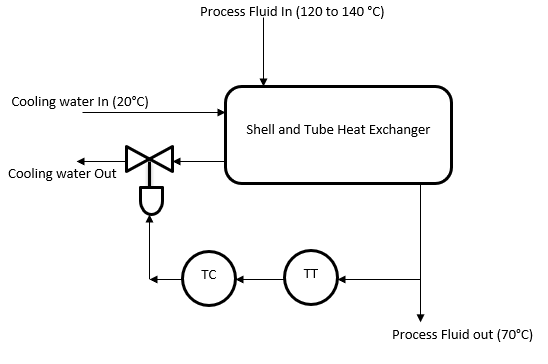
Introduction to Chemical Engineering Thermodynamics
8th Edition
ISBN: 9781259696527
Author: J.M. Smith Termodinamica en ingenieria quimica, Hendrick C Van Ness, Michael Abbott, Mark Swihart
Publisher: McGraw-Hill Education
expand_more
expand_more
format_list_bulleted
Concept explainers
Question
solve c) & d)

Transcribed Image Text:5. A two-pass shell-and-tube heat exchanger cools a hot liquid process stream (120 to 140 C
inlet temperature) to a desired temperature of 70 C using cooling water available at 20 C.
The hot process stream is on the shell side of the heat exchanger, while the cooling water is
on the tube side of the heat exchanger.
Hot process fluid in
Cooling water in
Cooling water out
Process fluid out
a) Briefly (30 words or less) discuss the objectives of a suitable feedback control strategy
for the process above.
b) What is your proposed controlled variable (CV)?
c) What is your proposed manipulated variable (MV)?
d) What are possible disturbances (DV)?
e) Draw your feedback control strategy onto the drawing above using typical symbols found
on a P&ID diagram.
f) Draw the control block diagram for your feedback process control loop, labeling all
signals and blocks on the diagram.
Expert Solution
arrow_forward
Step 1
Given:
Process fluid in at 120 to 140
Process fluid out at 70
Cooling water available at 20
Below is the heat exchanger with temperature control system:

Step by stepSolved in 3 steps with 1 images

Knowledge Booster
Learn more about
Need a deep-dive on the concept behind this application? Look no further. Learn more about this topic, chemical-engineering and related others by exploring similar questions and additional content below.Similar questions
- Q2/A) The system is shown in the next page: 1. Find the value of (m) when the damping ratio () is (0.7). Then obtain the maximum over shoot, peak time, rise time, and settling time. 2. Determine (on) and (C) when (m) equal zero. 3. Calculate the value of steady state error for this system if the input is a unit ramp. X(s) 250 Y(s) S(S+10) 3m S + 1arrow_forwardF1 F2 A2 P2 The following is known: Area, A1= 0.3 ft and A2= 7.6 A1- Assuming an incompressible fluid If a force F1 of 44.3 lbf / ft2 is applied at (1) then the resultant force, F2 in Ibf is equal to -- ?arrow_forwardexcel spreadsheetarrow_forward
arrow_back_ios
arrow_forward_ios
Recommended textbooks for you
 Introduction to Chemical Engineering Thermodynami...Chemical EngineeringISBN:9781259696527Author:J.M. Smith Termodinamica en ingenieria quimica, Hendrick C Van Ness, Michael Abbott, Mark SwihartPublisher:McGraw-Hill Education
Introduction to Chemical Engineering Thermodynami...Chemical EngineeringISBN:9781259696527Author:J.M. Smith Termodinamica en ingenieria quimica, Hendrick C Van Ness, Michael Abbott, Mark SwihartPublisher:McGraw-Hill Education Elementary Principles of Chemical Processes, Bind...Chemical EngineeringISBN:9781118431221Author:Richard M. Felder, Ronald W. Rousseau, Lisa G. BullardPublisher:WILEY
Elementary Principles of Chemical Processes, Bind...Chemical EngineeringISBN:9781118431221Author:Richard M. Felder, Ronald W. Rousseau, Lisa G. BullardPublisher:WILEY Elements of Chemical Reaction Engineering (5th Ed...Chemical EngineeringISBN:9780133887518Author:H. Scott FoglerPublisher:Prentice Hall
Elements of Chemical Reaction Engineering (5th Ed...Chemical EngineeringISBN:9780133887518Author:H. Scott FoglerPublisher:Prentice Hall
 Industrial Plastics: Theory and ApplicationsChemical EngineeringISBN:9781285061238Author:Lokensgard, ErikPublisher:Delmar Cengage Learning
Industrial Plastics: Theory and ApplicationsChemical EngineeringISBN:9781285061238Author:Lokensgard, ErikPublisher:Delmar Cengage Learning Unit Operations of Chemical EngineeringChemical EngineeringISBN:9780072848236Author:Warren McCabe, Julian C. Smith, Peter HarriottPublisher:McGraw-Hill Companies, The
Unit Operations of Chemical EngineeringChemical EngineeringISBN:9780072848236Author:Warren McCabe, Julian C. Smith, Peter HarriottPublisher:McGraw-Hill Companies, The

Introduction to Chemical Engineering Thermodynami...
Chemical Engineering
ISBN:9781259696527
Author:J.M. Smith Termodinamica en ingenieria quimica, Hendrick C Van Ness, Michael Abbott, Mark Swihart
Publisher:McGraw-Hill Education

Elementary Principles of Chemical Processes, Bind...
Chemical Engineering
ISBN:9781118431221
Author:Richard M. Felder, Ronald W. Rousseau, Lisa G. Bullard
Publisher:WILEY

Elements of Chemical Reaction Engineering (5th Ed...
Chemical Engineering
ISBN:9780133887518
Author:H. Scott Fogler
Publisher:Prentice Hall


Industrial Plastics: Theory and Applications
Chemical Engineering
ISBN:9781285061238
Author:Lokensgard, Erik
Publisher:Delmar Cengage Learning

Unit Operations of Chemical Engineering
Chemical Engineering
ISBN:9780072848236
Author:Warren McCabe, Julian C. Smith, Peter Harriott
Publisher:McGraw-Hill Companies, The